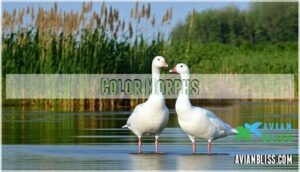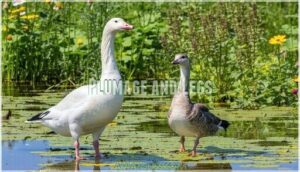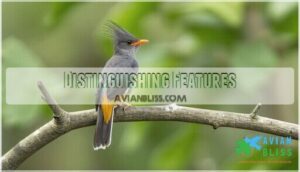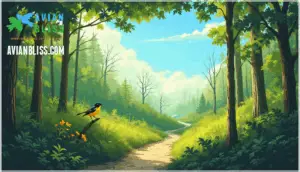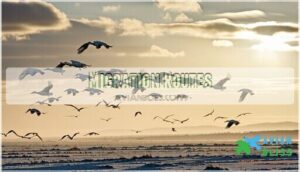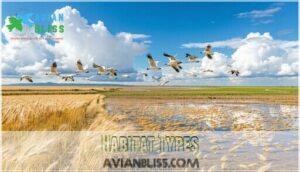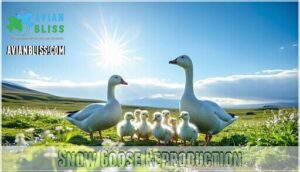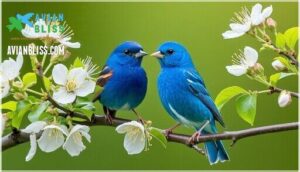This site is supported by our readers. We may earn a commission, at no cost to you, if you purchase through links.
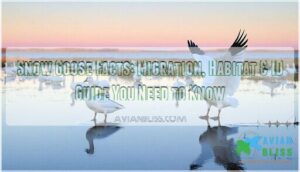
These birds measure 27-33 inches long and weigh 3.5-7.3 pounds. You’ll find two color variations: the common white morph and the striking dark gray "blue" morph with white head and neck.
Both types have pink legs and bills with black markings.
Snow geese breed in Arctic tundra across Canada and Alaska then migrate up to 3,000 miles along four major flyways to winter in southern marshes and agricultural fields.
They form lifelong pairs and nest in dense colonies.
Their remarkable navigation skills and social behaviors make them one of North America’s most fascinating migratory birds.
Table Of Contents
Key Takeaways
- You’ll recognize snow geese by their two color morphs – white birds with black wingtips or dark "blue" geese with bluish-gray bodies and white heads, both featuring distinctive pink bills with black "grin patches"
- You can witness one of nature’s most impressive migrations as these birds travel up to 3,000 miles between Arctic breeding grounds and southern wintering areas along four major flyways twice yearly
- You’ll find these social birds forming lifelong pair bonds and nesting in massive Arctic colonies, with parents working together to raise goslings that can walk and swim within 24 hours of hatching
- You’re looking at a conservation success story that’s created new challenges – snow goose populations recovered from near extinction but now face threats from climate change affecting their Arctic habitat and overgrazing from their own abundance
Snow Goose Description
You’ll quickly recognize a snow goose by its medium size and distinctive appearance. These geese have two color forms that make identification easier once you know what to look for.
Size and Weight
You’ll find snow geese are medium-sized waterfowl with impressive body mass.
These birds measure 27-33 inches long and weigh between 3.5-7.3 pounds.
Lesser snow geese typically weigh around 5.3 pounds while Greater snow geese reach 7.4 pounds.
Juvenile size is slightly smaller than adults during fall migration.
Weight variation depends on subspecies and seasonal conditions affecting their overall body mass.
Color Morphs
Snow Geese come in two distinct color morphs that’ll help you identify them in the field.
The white morph shows bright white plumage with black wingtips.
The blue morph displays a dark slaty-gray body with a white head and neck.
These aren’t separate species but genetic variations of the same bird.
Hybrid geese can show mixed traits between morphs.
Juvenile plumage appears duller in both forms, and these birds can be identified by their distinct color morphs and overall plumage characteristics.
Plumage and Legs
Adult snow geese display striking plumage differences between their two color morphs.
White morph birds showcase pure white bodies with black wingtips. Dark morph geese feature bluish-gray bodies with white heads and necks.
Both morphs have pink legs and bills with distinctive black grin patches.
Juvenile plumage appears duller with brownish bills and variable grayish markings across their developing feathers.
Distinguishing Features
Beyond color morphs and plumage details you’ve learned about, Snow Geese have three key distinguishing features that help with identification:
- Black "grin patch" – Adults display this distinctive curved black marking along their bill edges
- Bill characteristics – Their pink-orange bills feature serrated edges like a combination nutcracker and knife
- Size variations – Lesser Snow Geese measure 28 inches while Greater Snow Geese reach 31 inches
These distinctive features make identification easier regardless of the bird’s color pattern or juvenile plumage stage.
Their feathers provide insulation and waterproofing essential for survival.
Habitat and Distribution
Snow geese travel across North America following ancient migration routes that span thousands of miles.
These magnificent birds navigate continent-spanning journeys with remarkable precision each year.
You’ll find these remarkable birds in Arctic tundra during summer and southern marshes and farm fields during winter.
Breeding Grounds
Arctic tundra serves as the exclusive breeding grounds for snow geese.
The Arctic’s harsh beauty creates perfect nesting conditions for these remarkable birds
You’ll find these birds nesting in massive colonies across northern Canada and Alaska.
Females choose hummock selection sites on slightly elevated ridges near ponds or streams.
The harsh Arctic environment with its cold summers can limit successful reproduction.
Snow geese demonstrate remarkable territory return behavior, coming back to the same nesting areas year after year.
Wintering Grounds
During winter, you’ll spot snow goose flocks in Southern Habitats like the Central Valley of California and Gulf Coast states.
Food Availability in agricultural areas shapes their stay.
Here’s where you’ll find them:
- Grain fields with leftover crops.
- Freshwater and brackish marshes.
- Coastal estuaries.
- Areas with high Population Density, often influenced by Climate Change and Agricultural Impact.
Hunters often find success by targeting Arkansas spring snow goose populations.
Migration Routes
Snow goose migration follows four major flyways across North America.
You’ll spot these birds traveling the Pacific, Central, Mississippi, and Atlantic routes. Lesser snow geese use three flyways while Greater snow geese stick to the Atlantic.
These migratory routes span 2,000 to 3,000 miles between Arctic breeding grounds and southern wintering areas. Navigation methods help flocks reach traditional stopover habitats with remarkable precision each year.
The geese travel to breeding grounds in northeastern Canada and Greenland after spring snow goose migration.
Habitat Types
You’ll find snow geese thriving across diverse landscapes throughout their yearly cycle.
These adaptable birds call many different places home.
Snow geese utilize distinct habitat types during different seasons:
- Arctic Tundra – Breeding grounds near ponds and streams in northern Canada and Alaska
- Wintering Marshes – Coastal saltwater and freshwater wetlands from California to Texas
- Agricultural Fields – Corn, rice, and wheat fields providing abundant grain during migration
- Grassland Habitats – Prairie wetlands and meadows used as stopover sites during long journeys
From frozen tundra habitat to warm coastal regions, snow geese adapt to whatever environment meets their needs.
Behavior and Diet
You’ll discover that snow geese are highly social birds with fascinating feeding and migration behaviors.
These remarkable waterfowl travel thousands of miles each year while maintaining complex social structures and communication systems.
Foraging Habits
Watching these goose species march across fields like feathered bulldozers reveals their incredible foraging behavior.
Snow geese use their specialized bills for grubbing up roots and grazing vegetation.
Their feeding behavior shows remarkable dietary adaptations.
Chen caerulescens demonstrates seasonal variation in food preferences.
During breeding they target sedges and grasses.
Winter brings shifts to agricultural crops.
Their feeding strategies matter for survival.
These foraging locations create significant impact agriculture faces from large flocks.
Migration Patterns
These arctic birds follow predictable flyway routes during their epic journeys.
Snow goose migration timing spans spring and fall seasons. Large flocks use established stopover sites to refuel along major flyways.
Their navigation methods include celestial cues and landmarks. Migratory patterns connect Arctic breeding grounds to southern wintering areas.
Flock dynamics help birds conserve energy during long flights, utilizing established stopover sites and following predictable flyway routes.
Social Structure
You’ll spot snow geese in massive flocks that can number in the thousands. These birds stick together through thick and thin.
Flock dynamics revolve around safety in numbers. Family groups stay close during migration. Parents keep their young nearby for protection.
Mixed flocks often include other goose species. Social hierarchy exists within these groups. Dominant birds lead the way during flight and feeding.
Communication
You’ll recognize snow geese by their distinctive honking calls that sound like barking dogs.
These alarm calls alert the entire flock to danger while they forage. During migration flocks communicate through various call types to stay together.
Pairs use soft vocalizations for bonding throughout their lifelong relationships. Juvenile learning happens through mimicking adult goose sounds, which is a key part of their development and involves lifelong relationships.
Snow Goose Reproduction
Snow geese form lifelong pairs and breed in dense Arctic colonies during summer months.
You’ll find these devoted parents working together to raise their young through a precise reproductive cycle that guarantees species survival.
Mating and Breeding
Snow geese find their perfect match through pair bonding that lasts a lifetime. These birds choose partners before or during spring migration. Males court females with synchronized neck stretching displays. Once paired they stick together through thick and thin.
Snow geese mate for life, bonding through synchronized courtship displays that cement lifelong partnerships
Here’s how their mating system works:
- Partners return to the same breeding territories each year
- Courtship involves rapid neck movements performed in unison
- First-time breeders typically start at age three, which is a significant aspect of their lifetime journey.
Nesting Habits
When females return to breeding grounds they select nest sites on elevated ridges or small hummocks within dense colonies.
These colonial nesting areas provide safety in numbers against predators.
Each snow goose pair creates a shallow depression in the tundra and lines it with grasses and soft down.
One vital aspect is nest site selection for safety. The nest construction happens quickly before egg laying begins.
Incubation Period
Once a female begins incubation, she’ll dedicate over three weeks to warming her eggs.
The incubation period lasts 22-23 days. During this time, parental roles become clear.
Females handle all egg development while males stand guard nearby. Nest attendance remains constant for proper hatching success.
This dedicated approach guarantees healthy hatchlings emerge ready for Arctic life, ensuring the young are well-prepared for the challenges they will face, with proper hatching success.
Gosling Development
Looking at tiny hatchlings just days old fills you with wonder.
Goslings leave their nest within 24 hours of hatching.
They can walk and swim immediately.
Parents provide constant care during these early growth stages.
The gosling diet includes tender grasses and protein-rich insects.
First flight happens after 43 days of rapid gosling development, which is a result of constant care.
Conservation Status
You’ll find that snow geese have become one of North America’s biggest conservation success stories. These birds went from near extinction to overpopulation in just decades.
Population Decline
After successful breeding comes a harsh reality. You’re witnessing one of North America’s most dramatic wildlife collapses. The midcontinent goose population has crashed 70% from its peak.
Four key factors drive this population decline:
- Arctic Changes – Cold rainfall kills goslings during critical early weeks
- Habitat Degradation – Overgrazing destroyed 35% of Hudson Bay breeding grounds
- Disease Risk – High-density colonies spread avian cholera outbreaks
- Climate Effects – Warming threatens 97% of current breeding range
This alarming trend underscores the devastating effects on bird species due to environmental changes. Human Impact and Hunting Impact remain secondary to these environmental pressures affecting goose population trends and conservation status.
Recovery Efforts
You made a recovery effort during the 1990s.
Conservation efforts enabled populations to rebound, and regulated hunting has been permitted now for almost 50 years.
Now snow goose population management uses special hunting regulations.
Recent conservation hunts implemented in Canada and the US have been successful in doubling the harvest rates of snow geese and bringing down the populations of both lesser and greater snow geese.
These conservation efforts include habitat restoration in Arctic conservation areas.
Agricultural impacts also help control population recovery through targeted population management programs across North America.
Current Threats
Despite their impressive population recovery, you’ll find snow geese still face significant conservation challenges today.
Climate change disrupts their Arctic breeding grounds while habitat loss continues across migration routes. Hunting pressure remains high through special harvest seasons designed to control populations.
Here are the main threats affecting snow geese:
- Habitat Loss – Wetland drainage and urban development eliminate essential stopover sites along migration corridors
- Climate Change – Rising temperatures alter Arctic vegetation timing and reduce suitable nesting areas
- Disease Outbreaks – Dense flocking facilitates avian cholera and influenza transmission in breeding colonies
- Hunting Pressure – Liberal harvest quotas aim to reduce crop damage but may impact local populations
- Human Impact – Agricultural conflicts and airport safety concerns create ongoing management challenges
These climate threats affect their conservation status through habitat degradation and population decline in some regions, despite overall abundance.
Understanding the bird conservation status is crucial for addressing the complex issues surrounding snow goose populations.
Conservation Measures
Wildlife agencies have launched multiple conservation strategies to protect snow geese populations.
Habitat Preservation programs secure critical breeding and wintering areas through protected reserves.
Hunting Regulations now include extended seasons to manage overpopulation issues.
Population Management involves annual surveys and adaptive harvest limits.
Climate Impacts research guides long-term planning efforts.
Agricultural Changes create new feeding opportunities but require careful monitoring for sustainable bird conservation outcomes, considering the effects of climate.
Frequently Asked Questions (FAQs)
How rare is a snow goose?
Snow geese aren’t particularly "feathered rarities" anymore.
You’ll find them thriving across North America in massive flocks.
Their populations have actually grown substantially due to abundant agricultural food sources in wintering grounds throughout recent decades, which has made them a common sight.
What is another name for a snow goose?
Another name for the snow goose is the "blue goose".
This refers to the dark morph of the same species that has a bluish-gray body with a white head and neck instead of the all-white plumage.
What is a snow goose?
A bird in the hand is worth two in the bush.
You’ll spot this medium-sized goose by its hefty bill, long neck, and two color types—white or dark.
It grazes wetlands, fields, and tundra.
What does a snow goose look like?
You’ll spot a medium-sized goose with striking features.
White morphs have pure white bodies with black wingtips and pink-orange bills.
Dark morphs display bluish-gray bodies with white heads.
Both have pink legs and distinctive black "grin patches" on their beaks and bodies.
Are there snow geese in the UK?
Unlike North America where they’re common, you’ll rarely see these arctic visitors in Britain.
Most Snow Geese in Britain are escaped captives, but some genuine vagrants arrive with Pink-footed Geese.
They’re fairly regular in Lancashire and appear as wild birds in Scotland annually.
The Snow Goose population is protected under conservation status laws to guarantee their safety and is considered a significant aspect of wildlife conservation.
What morph is a snow goose?
Snow geese display two distinct color morphs. You’ll see the white morph with black wingtips and the blue morph with dark slaty-gray bodies and white heads.
Is snow goose a migrati?
Like a restless wanderer following ancient pathways, you’ll witness nature’s greatest journey.
Snow geese are exceptional migrants, traveling thousands of miles between Arctic breeding grounds and southern wintering areas in massive flocks twice yearly.
Is a Blue Goose a snow goose?
Yes, a Blue Goose is actually a snow goose.
You’re looking at the same species with different color morphs.
The dark morph has bluish-gray body plumage with a white head and neck, while the white morph appears completely white with black wingtips.
What is special about snow geese?
You’ll find these remarkable birds fascinating because they’re one of North America’s most abundant waterfowl species.
They’re capable of incredible Arctic-to-southern migrations spanning thousands of miles with their distinctive black wingtips and pink bills.
Is a blue goose a snow goose?
You’re looking at the same bird with different looks.
Blue geese are actually the dark color morph of snow geese.
Both white and blue phases belong to the same species.
They can even breed together and produce mixed-colored offspring.
Conclusion
Researchers tracked one snow goose that flew 2,400 miles nonstop over the Atlantic Ocean.
This shows how tough these birds really are. Snow geese are amazing travelers that cross entire continents twice each year.
You can spot them by their white feathers and black wingtips. They live in large groups and mate for life.
These birds face challenges from habitat loss and climate change. Understanding snow goose behavior helps us protect their migration routes for future generations.


